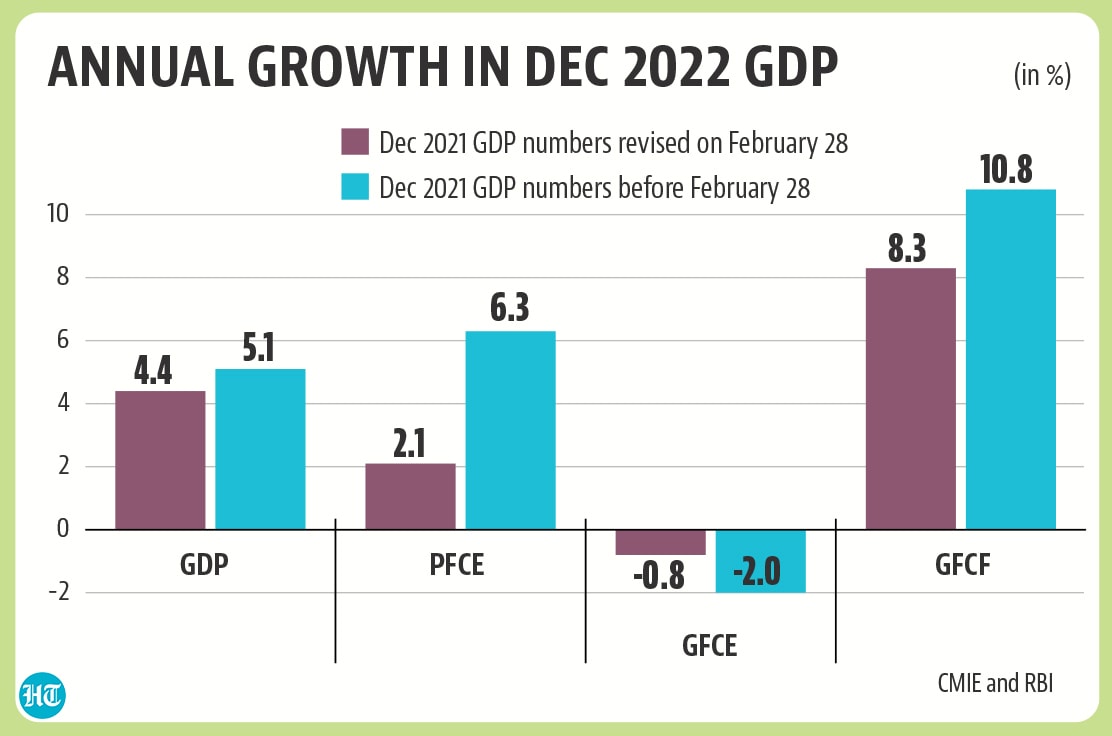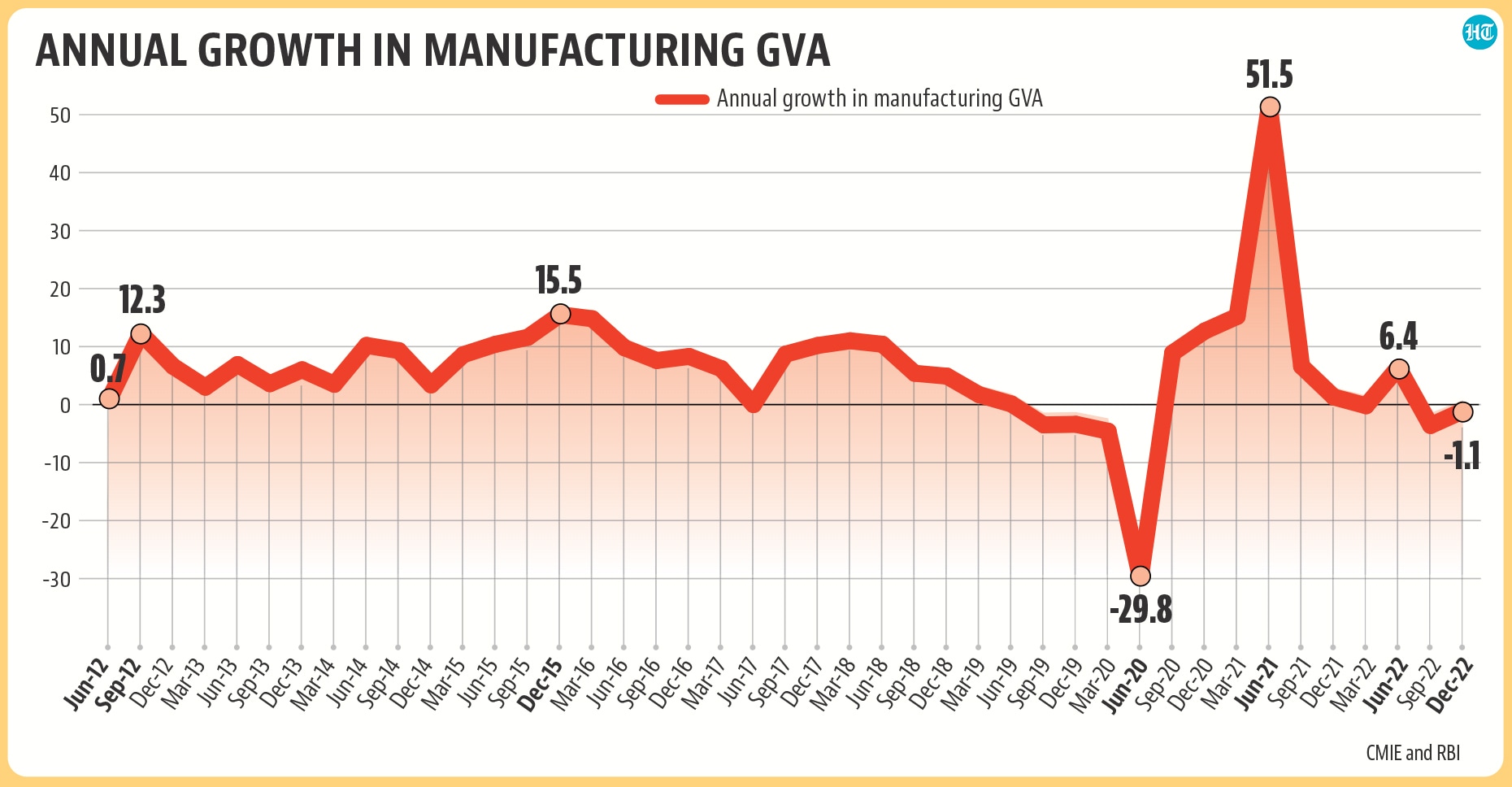On February 28, the National Statistical Office (NSO) released GDP numbers for the quarter ending December 2022. While analysis of GDP statistics is normally a straightforward exercise, the latest release included revisions to past GDP statistics in keeping with NSO’s revision calendar. Because significant changes have been made to past GDP statistics, there is some amount of confusion as to how to read the latest numbers. Here are three charts that try to answer this question.
The headline GDP numbers show a broad-based slowdown …
GDP growth in the quarter ending December 2022 stood at 4.4%. A comparison of growth rates for major components of GDP shows that the economy has been losing momentum in the current fiscal year across the board. The most alarming slowdown is evident in private final consumption expenditure (PFCE) which has a share of 60% in total GDP in the December 2022 quarter.
“The weakness in private consumption stood out, not just slowing on a y-o-y basis (2.1% y-o-y versus 8.8% last quarter), but also on the basis of our preferred metric (14.8% growth between December 2019 and 2022, compared to 15.2% growth between September 2019 and 2022)”, HSBC economists Pranjul Bhandari and Aayushi Chaudhary said in a note.
While capital formation is still showing impressive growth rate, a slowdown can be seen even there. Slowing exports point to weakening of external demand for the economy. However, a more than proportionate slowdown in imports has mitigated growth headwinds from exports to some extent.
See Chart 1: Major components of GDP growth from June 2022 to December 2022
… but, some of the slowdown is solely due to data revision
The first reaction to the GDP numbers when they were released on February 28 was that they were lower than what was expected. A Bloomberg poll of economists had put this number at 4.7%. However, there is some merit in the argument that some of the divergence in the expected and actual GDP growth number is because the past number has changed. For example, if one were to calculate GDP growth on the basis of December 2021 quarter numbers available before February 28, headline GDP growth in December 2022 quarter will come to 5.1% rather than 4.4%. To be sure, the problem is intrinsic to the way in which NSO releases its data, as revised GDP estimates from the past force a change of base for growth calculations.
“When one set of data is revised to take into account underlying data revisions, larger samples, etc., and the other is not, it is not a like-for-like comparison”, Chief Economic Advisor V. Anantha Nageswaran said in a note circulated to journalists.
See Chart 2: December 2022 GDP growth using December 2021 GDP data before and after February 28 revision
Manufacturing remains an area of concern even with this caveat
Gross Value Added (GVA) in manufacturing contracted by 1.1% in the quarter ending December 2022. This is the third contraction in manufacturing in 2022, something that has never happened in the current GDP series. While, part of the manufacturing performance can be attributed to the revision of historical numbers, experts believe that manufacturing continues to be an area of concern.
“Both YoY growth and sequential growth reflect a similar story of continued weakness in manufacturing activity and strong momentum in construction activity. Overall, in the first three quarters of FY23, Real GVA manufacturing growth is a mere 0.4%YY vs 10%YY growth in Real GVA construction. This is consistent with the trend in employment data, where construction jobs are well ahead of pre-Covid levels, but manufacturing jobs momentum is more subdued”, Samiran Chakraborty, Chief India economist at Citibank said in a note.
See Chart 3: Manufacturing GVA growth
Which way for the economy now?
NSO’s assumption of 2022-23 GDP growing by 7% implies a GDP growth of 5.1% in the March 2023 quarter. In its resolution dated February 8, RBI’s Monetary Policy Committee projected quarterly growth rates of 7.8%, 6.2%, 6% and 5.8% in the four quarters beginning June 2023, which implies an annual GDP growth of 6.4% in 2023-24.
Private sector analysts, have a more sober assessment . “We believe that overall growth momentum is softening, as pent-up demand from the lockdown period fades, exports weaken, and tighter fiscal and monetary policy rate take their toll. We expect GDP growth to slow from 6.8% in FY23 to 5.5% in FY24”, Bhandari and Chaudhary added.
“We believe India’s growth cycle has peaked, and a combination of weaker global growth and tight domestic and global financial conditions could further impair the growth drivers viz. exports, investment and discretionary consumption. We forecast GDP growth to moderate from 6.7% y-o-y expected in FY23 to 5.3% in FY24”, Nomura economists Sonal Varma and Aurodeep Nandi said in a note.



